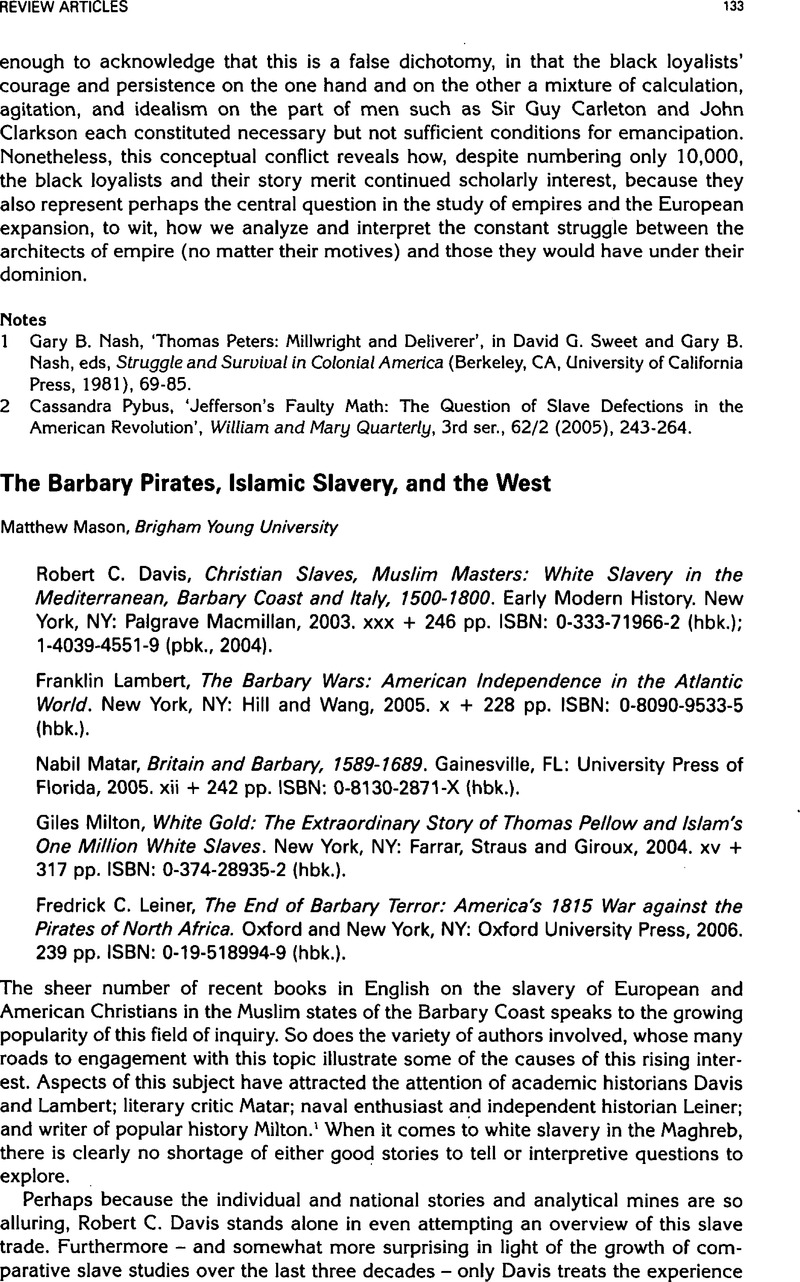No CrossRef data available.
Article contents
The Barbary Pirates, Islamic Slavery, and the West
Review products
Published online by Cambridge University Press: 22 April 2010
Abstract

- Type
- Review Articles
- Information
- Copyright
- Copyright © Research Institute for History, Leiden University 2006
References
Notes
1 This is just the beginning, and just in English, of course. Another notable recent title in English is the narrative of an African-American enslaved in the Maghreb: Adams, Charles Hanford, ed., The Narrative of Robert Adams, A Barbary Captive: A Critical Edition (Cambridge and New York, NY: Cambridge University Press, 2005).CrossRefGoogle Scholar A recent anthology of such captivity narratives has proven influential: Baepler, Paul, ed., White Slaves, African Masters: An Anthology of American Barbary Captivity Narratives (Chicago, IL: University of Chicago Press, 1999)Google Scholar.
2 That Davis would be a pioneer in this field in the year 2003 is a telling contrast to the mature, ongoing scholarship in the wake of Curtin, Philip D., The Atlantic Slave Trade: A Census (Madison, WI: University of Wisconsin Press, 1969).Google Scholar A recent entry in this enormous historiography, McMillin, James A., The Final Victims: Foreign Slave Trade to North America, 1783–1810 (Columbia, SC: University of South Carolina Press, 2004),Google Scholar joins Davis as a model of care in approaching such a census.
3 This section of Davis' book is reminiscent of the historical imagination and useful comparative treatment for the Roman slave trade by Bradley, Keith, Slavery and Society at Rome (Cambridge and New York, NY: Cambridge University Press, 1994),CrossRefGoogle Scholar except that Davis has much better sources than Bradley to go along with the imagination.
4 For another recent, and more systematic, case for the necessity of state formation to protect American commerce abroad (among other things), see Edling, Max M., A Revolution in Favor of Government: Origins of the U.S. Constitution and the Making of the American State (Oxford and New York, NY: Oxford University Press, 2003)CrossRefGoogle Scholar.
5 ‘Arguably’ because while all these authors agree that these twin attacks on Algiers ended the practice - although they indirectly quibble by emphasis over which nation deserves more credit for this achievement - Davis' tables show 1,642 slaves in Algiers in 1816, and 122 in 1830 (Davis, xix).
6 Eugene, D. Genovese, Roll, Jordan, Roll: The World the Slaves Made (New York, NY: Pantheon Books, 1974).Google Scholar
7 For an early formulation of this distinction, see Finley, M.I., Ancient Slavery and Modern Ideology (New York, NY: Viking Press, 1980), ch. 2.Google Scholar See also Ira Berlin's influential recent applications of Finley's theoretical insight, in Many Thousands Gone: The First Two Centuries of Slavery in North America (London and Cambridge, MA, Harvard University Press, 1998)Google Scholar; and: Generations of Captivity: A History of African-American Slaves (London and Cambridge, MA: Harvard University Press, 2003)Google Scholar.


